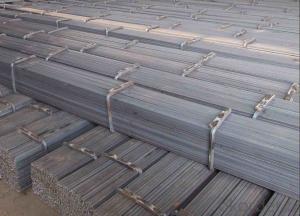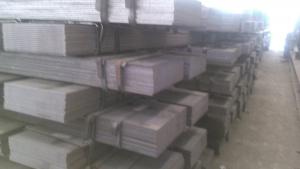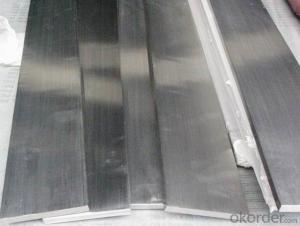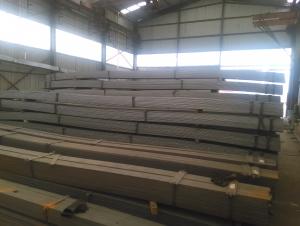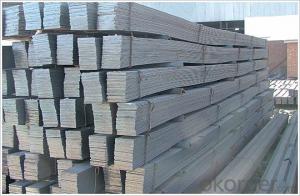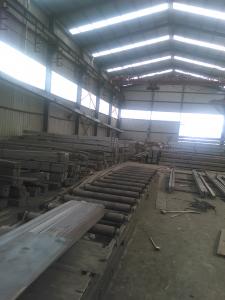FLAT BAR 20-200
- Loading Port:
- China Main Port
- Payment Terms:
- TT OR LC
- Min Order Qty:
- -
- Supply Capability:
- -
OKorder Service Pledge
OKorder Financial Service
You Might Also Like
Product Description:
Product Description:
Specification of Mild Steel Flat Bar
Commodity: Mild Steel Flat Bar
Standard: GB;JIS
Material: Q195-235;SS400
Brand name: FLATSPACE
Origin place: China
Thickness: 3mm-30mm
Width:20mm-200mm
Length: Max 12m
Certification: SGS/BV
Chemical composition of Q235
Alloy No | Grade | Element(%) | ||||
C
| Mn
| S
| P
| Si
| ||
Q235
|
B
|
0.12—0.20 |
0.3—0.7 |
≤0.045 |
≤0.045
|
≤0.3
|
Physical properties of Q235
Alloy No | Grade | Yielding strength point(Mpa) | Tensile strength (Mpa) | Elongation after fracture(%) | ||||||
Thickness (mm) | Thickness (mm) | |||||||||
≤16 | >16--40 | >40--60 | >60--100 |
| ≤16 | >16--40 | >40--60 | >60--100 | ||
≥ | ≥ | |||||||||
Q235 |
B |
235 |
225 |
215 |
205 |
375--500 |
26 |
25 |
24 |
23 |
Usage/Applications of Mild Steel Flat Bar
Widely used for construction, Machinery manufacturing, Iron tower steel structure, Shipbuilding; Steel grating, Staircase, Bridge, Viaduct, Railway spare parts, Boilers making etc.
Packaging & Delivery of Mild Steel Flat Bar
Packaging Details: The Mild Steel Flat Bars are packed in bundles and loaded in 20 feet/40 feet container, or shipped by bulk cargo ,also we can do as customer's requirements.
Delivery Details:30~45 days upon the receipt of buyer payment by T.T. or L/C.
Production Flow of Mild Steel Flat Bar
The Mild steel flat bar is made through three processes:
1.Feeding the material: Feeding the row material (the steel plate) to Slitting Line.
2.Slitting:The steel plate would be slitted into expected width by lengthways cutter.
3. Leveled and cutting: The plat bar would be ground into level by the grinder and then cut into required length
- Q:What are the benefits of using steel flat bars in architectural projects?
- There are several benefits of using steel flat bars in architectural projects. Firstly, steel flat bars offer high tensile strength and exceptional durability, making them suitable for supporting heavy loads and withstanding harsh weather conditions. Secondly, their versatility allows for various applications such as framing, support structures, and decorative elements. Additionally, steel flat bars are malleable, making it easier to shape and customize according to specific project requirements. Moreover, steel's corrosion resistance minimizes the need for regular maintenance and ensures long-term performance. Lastly, steel is a sustainable and environmentally friendly material, as it can be recycled indefinitely without losing its properties, reducing the overall environmental impact of architectural projects.
- Q:What are the different heat treatment processes for steel flat bars?
- There are several heat treatment processes that can be applied to steel flat bars to enhance their mechanical properties and improve their overall performance. Some of the commonly used heat treatment processes for steel flat bars include: 1. Annealing: This process involves heating the steel flat bar to a specific temperature and then slowly cooling it to room temperature. Annealing helps to relieve internal stresses, increase ductility, and improve machinability. 2. Normalizing: This heat treatment process involves heating the steel flat bar to a temperature above its critical range and then allowing it to cool in air. Normalizing helps to refine the grain structure, improve mechanical properties, and enhance the overall toughness of the steel. 3. Quenching and tempering: This two-step process involves rapid cooling, or quenching, the steel flat bar in a liquid medium, such as oil or water, to achieve high hardness. This is followed by tempering, which involves reheating the quenched steel to a lower temperature to reduce brittleness and improve toughness. 4. Case hardening: Also known as carburizing, this process involves adding carbon to the surface of the steel flat bar by heating it in a carbon-rich environment. Case hardening creates a hard outer layer while maintaining a softer and more ductile core, enhancing wear resistance and providing a tough surface. 5. Stress relieving: This heat treatment process is used to reduce residual stresses in the steel flat bar that may have accumulated during manufacturing or other processes. It involves heating the steel to a specific temperature and allowing it to cool slowly. Stress relieving helps to minimize distortion and improve dimensional stability. These heat treatment processes can be tailored to meet specific requirements and desired mechanical properties of the steel flat bars, making them suitable for a wide range of applications in various industries.
- Q:Are steel flat bars suitable for making brackets or supports?
- Yes, steel flat bars are suitable for making brackets or supports. Steel flat bars are strong and durable, making them ideal for providing structural support. They can be easily cut, shaped, and welded to create custom brackets or supports for various applications. Additionally, steel flat bars offer excellent resistance to bending and twisting forces, ensuring stability and reliability in any construction or engineering project.
- Q:What is the difference between hot-rolled and cast steel flat bars?
- Hot-rolled and cast steel flat bars differ primarily in their manufacturing processes and resulting properties. Hot-rolled steel flat bars are created by heating a steel billet or ingot to a high temperature and then passing it through a series of rollers to achieve the desired shape and dimensions. This procedure yields a product with a rougher surface and slightly curved edges. Known for their malleability and ductility, hot-rolled steel flat bars are suitable for a wide range of applications in construction, manufacturing, and general fabrication due to their strength and versatility. On the contrary, cast steel flat bars are formed by pouring molten steel into a mold, allowing it to cool and solidify into the desired shape. This method yields a product with a smoother surface and sharp edges. Typically, cast steel flat bars are harder and more brittle than hot-rolled steel flat bars, making them ideal for applications that require higher strength and wear resistance. They are commonly used in industries like mining, agriculture, and machinery manufacturing, where durability and toughness are crucial. To summarize, the main distinctions between hot-rolled and cast steel flat bars can be found in their manufacturing processes, resulting surface finishes, and mechanical properties. Hot-rolled steel flat bars possess malleability, versatility, and a rougher surface, while cast steel flat bars are harder, more brittle, and have a smoother surface. The choice between the two depends on the specific requirements of the application, such as strength, durability, and surface finish.
- Q:What are the different standards for steel flat bars?
- Steel flat bars, also known as steel flats or flats, are available in a variety of standards that determine their size, shape, and composition. These standards are established to guarantee consistency and excellence in the production and utilization of steel flat bars. One highly recognized standard for steel flat bars is the ASTM A36, which outlines the prerequisites for carbon structural steel. This standard specifies the chemical composition, mechanical properties, and dimensional tolerances for steel flats used in general structural purposes. Another frequently used standard is the ASTM A108, which covers carbon steel bars for general applications. This standard categorizes steel flat bars into different grades based on their chemical composition and mechanical properties. For more specialized applications, there are specific standards tailored to different industries. For example, the ASTM A276 is a standard that pertains to stainless steel bars and shapes. Within this standard, there are specific requirements for stainless steel flat bars, including their chemical composition, mechanical properties, and dimensions. In addition to ASTM standards, there are also international standards that govern the production and use of steel flat bars. The most notable one is the EN 10058, a European standard that specifies the tolerances on dimensions and shape for hot-rolled steel flat bars. Moreover, there are regional or national standards that may apply in certain countries. For instance, the JIS G3194 is a Japanese industrial standard that provides specifications for hot-rolled steel flat bars used in general structures. These standards are crucial to ensure the quality, compatibility, and interchangeability of steel flat bars in different applications. Manufacturers, engineers, and users rely on these standards to choose and work with steel flat bars that meet their specific requirements and adhere to industry norms.
- Q:Can steel flat bars be used for manufacturing medical devices?
- Medical devices can indeed be manufactured using steel flat bars. Steel boasts versatility as a material, offering a broad range of properties including strength, durability, and corrosion resistance. Consequently, it finds suitability in various applications within the medical field. When it comes to crafting medical devices like surgical instruments, orthopedic implants, and prosthetics, steel flat bars can be easily manipulated and formed into the necessary shapes. Moreover, they prove efficient in terms of sterilization and cleaning, a crucial factor for upholding hygiene standards in medical settings. Nevertheless, it is worth noting that the specific grade and type of steel required may vary depending on the device and its intended purpose. It is imperative to adhere to pertinent industry standards and regulations throughout the manufacturing process.
- Q:What are the different types of tests performed on steel flat bars?
- The different types of tests performed on steel flat bars include visual inspection, dimensional measurement, tensile testing, hardness testing, impact testing, and chemical analysis.
- Q:What are the different methods of surface coloring for steel flat bars?
- There are several different methods of surface coloring for steel flat bars, each with its own unique advantages and applications. Some of the most commonly used methods include: 1. Hot-dip galvanizing: This process involves immersing the steel flat bar into a bath of molten zinc, which creates a protective layer on the surface. Galvanizing provides excellent corrosion resistance and is often used in outdoor or high-moisture environments. 2. Powder coating: Powder coating involves applying a dry powder paint to the surface of the steel flat bar, which is then cured using heat. This method offers a wide range of color options, excellent durability, and resistance to chipping, scratching, and fading. 3. Electroplating: Electroplating is a process where a thin layer of metal, such as chrome or nickel, is deposited onto the steel flat bar's surface using an electric current. This method can enhance the appearance of the steel while also providing corrosion resistance. 4. Paint coating: The traditional method of applying paint directly to the surface of the steel flat bar is still widely used. It allows for a wide variety of colors and finishes, but the durability and corrosion resistance may not be as high as other methods. 5. Chemical coloring: This method involves using chemicals to create a controlled oxidation process on the steel flat bar's surface, resulting in various colors and shades. Chemical coloring can provide an attractive appearance while also increasing corrosion resistance. 6. Anodizing: Anodizing is primarily used for aluminum, but it can also be applied to steel flat bars. It involves creating an oxide layer on the surface through an electrochemical process, resulting in enhanced corrosion resistance and the ability to add color through dyes. Each of these methods has its own set of advantages and considerations, such as cost, environmental impact, durability, and aesthetic appeal. The choice of surface coloring method will depend on the specific requirements of the application, including the desired appearance, level of corrosion resistance, and budget constraints.
- Q:What are the different specifications for steel flat bars?
- Steel flat bars come in a variety of specifications, which determine their size, shape, and composition. These specifications include dimensions, such as width, thickness, and length, as well as the type of steel used and any additional properties. In terms of dimensions, steel flat bars can vary widely. Common widths range from 1/2 inch to 12 inches, while thicknesses can range from 1/8 inch to several inches. Lengths are typically specified in feet or meters, with standard lengths available, such as 6 or 12 feet, or custom lengths cut to the desired size. The type of steel used in flat bars can also vary. The most common types include carbon steel, which is a basic and versatile option, and stainless steel, which offers corrosion resistance and aesthetic appeal. Carbon steel flat bars are further classified based on their carbon content, with low-carbon, medium-carbon, and high-carbon steel being common options. In addition to the basic specifications, steel flat bars can have additional properties based on their intended use. For example, some flat bars may be heat-treated to increase their strength or hardness, while others may be galvanized or coated to enhance their resistance to corrosion. It is worth noting that different countries and industries may have their own specific standards or specifications for steel flat bars. These standards, such as ASTM (American Society for Testing and Materials) or EN (European Norms), ensure consistency and quality across different manufacturers and applications. Therefore, it is important to consider these standards and specifications when selecting steel flat bars for a particular project or application.
- Q:Can steel flat bars be used in food processing industries?
- No, steel flat bars are not typically used in food processing industries as they can corrode over time and contaminate the food. Stainless steel is the preferred material due to its corrosion resistance and hygienic properties.
1. Manufacturer Overview |
|
|---|---|
| Location | |
| Year Established | |
| Annual Output Value | |
| Main Markets | |
| Company Certifications | |
2. Manufacturer Certificates |
|
|---|---|
| a) Certification Name | |
| Range | |
| Reference | |
| Validity Period | |
3. Manufacturer Capability |
|
|---|---|
| a)Trade Capacity | |
| Nearest Port | |
| Export Percentage | |
| No.of Employees in Trade Department | |
| Language Spoken: | |
| b)Factory Information | |
| Factory Size: | |
| No. of Production Lines | |
| Contract Manufacturing | |
| Product Price Range | |
Send your message to us
FLAT BAR 20-200
- Loading Port:
- China Main Port
- Payment Terms:
- TT OR LC
- Min Order Qty:
- -
- Supply Capability:
- -
OKorder Service Pledge
OKorder Financial Service
Similar products
New products
Hot products
Hot Searches
Related keywords
